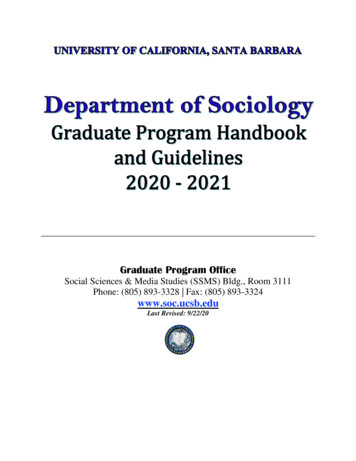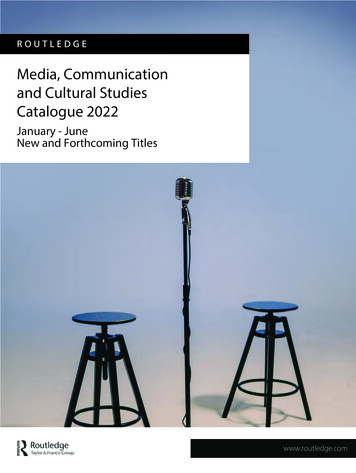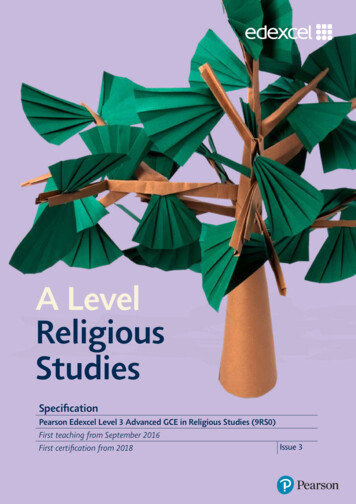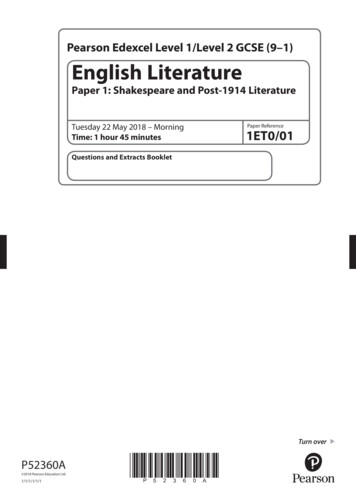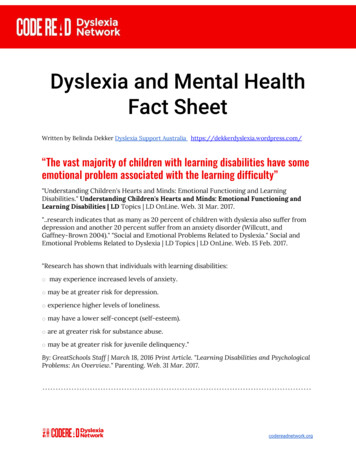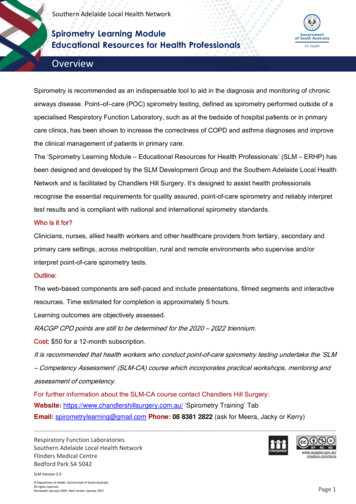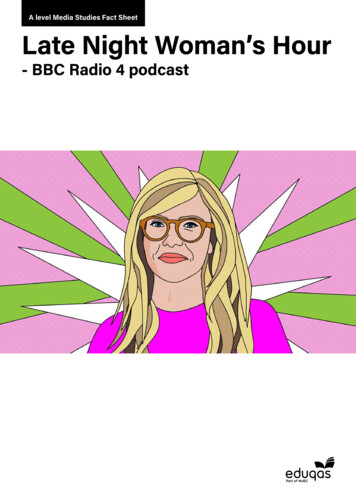
Transcription
A level Media Studies Fact SheetLate Night Woman’s Hour- BBC Radio 4 podcast
A level Media Studies Fact SheetLate Night Woman’s Hour- BBC Radio 4 podcastAS Component 1:Investigating the MediaA level Component 1: Media Products,Industries and AudiencesConsider the specialised and institutionalisednature of media production and thesignificance of economic factors tomedia industries and their products: Focus areas:Media IndustriesAudiencesMedia ContextsPRODUCT CONTEXT Late Night Woman’s Hour is a spin-off fromthe long-running BBC Radio 4 daily magazineprogramme, Woman’s Hour. It beganbroadcasting in 2015 on a limited basis butwas so popular that it began a permanent runas a monthly, then in 2018, a weekly podcast. Late Night Woman’s Hour is recorded weekly,hosted by Emma Barnett (occasionallywith founder Lauren Laverne) and featuresfemale guests from a range of backgroundsincluding science, health and entertainment. Each episode focuses on a particular themerelevant to its female audience e.g. ‘LostFriends’ and ‘Extreme Breastfeeding’. Theoriginal broadcast was at 11pm on Thursdaynights, which meant explicit and honestdiscussions could be had. Since becoming apodcast, the show has been less controversial. Explore issues relating to public servicebroadcasting and consider the extent to whichLate Night Woman’s Hour meets the BBC remitto inform, educate and entertain. Considerwhether the broadcast is typical of productscreated for the BBC and explore the hallmarksof productions made for this institution.Consider the significance of license fee fundingand compare this to the financial considerationsof commercial radio e.g. would this podcastbe too “niche” for commercial radio? Thebroadcast has only female contributors, ismade up predominantly of unadorned dialogue(without music, sound effects etc.) and the topicis explored using intellectual and specialisedvocabulary. Learners might discuss whypurely commercial institutions would beless likely to produce similar products.How significant is the move from broadcastto podcast? What could this tell us aboutthe changes in the media forms the BBC isproducing and the way they distribute them?Consider recent technological change and mediaproduction, distribution and circulation and theimpact of digitally convergent media platforms: PART 1: STARTING POINTS – Media IndustriesHistorical Contexts:Woman’s Hour was first broadcast in the 1940s,so it’s worth considering the historical andsocial shifts that have occurred since the show’sinception. The original show reflects possibletokenism (a show set aside for women mightimply all other radio content was orientedtowards men). Late Night Woman’s Hour featuresfrank and open discussions and demonstratessocietal shifts and increased gender equalityalthough some of the issues raised reflect thefact that society is not yet completely equal. 1The podcast offers a number of ways toexplore recent changes to the radio industryin relation to digital technology such as theprofound changes that have been broughtabout by switching from analogue FM radioto digital audio broadcasting (DAB), andthe boom in downloading and streaming.A brief history of radio before the mid1990s should allow learners to appreciate thesignificance of podcasting and listening tobroadcasts on digitally convergent platformssuch as computers and smartphones.In November 2018, the BBC launched itsBBC Sounds streaming service, featuringlive broadcasting, audio-on-demandand podcasts. This a good example oftechnological convergence as Sounds is
A level Media Studies Fact Sheet available on PCs, laptops, tablets, phones.Late Night Woman’s Hour used to have an11pm broadcast time that was suitable for theadult discussions taking place. The switch toweekly podcast gives the producers more timeto discuss a greater range of issues, but thetopics and discussion are less explicit. Episodescan be any length, usually 10-30 minutes.Podcasts have soared in popularity in the pastfew years, with many - such as Serial - becomingcultural events in their own right. Minoritygroups who have traditionally been excludedfrom mainstream radio have used podcaststo find a voice, and producers have utilisedthe lack of regulation to discuss controversialissues, especially personal or sexual matters.Female-produced podcasts such as The HighLow and The Broad Experience not onlyexplore issues affecting women in society, theyalso attract high profile guests that rival thoseof traditional radio. Comedy podcast DopeQueens even had Michelle Obama as a guest!BBC Radio, whilst being a traditionalmedia institution, does not treat theseindependent podcasts as competition. Ratherthey build a symbiotic relationship with thepresenters, often inviting them to guest onBBC Radio programmes (Radio 1, 4 and 6particularly do this). This could be seen asan example of cross-media convergence.A good example of this is regular LNWHguest Chidera Eggerue, who writes andpresents The Slumflower blog and podcast.Controversial comments she made aboutrace and feminism were re-tweeted andshared across social media, creating debateand promoting the ‘edgy and candid’ brandidentity of both The Slumflower and LNWH. Consider theoretical approaches:Power and media industries - Curran and Seaton Consider how media producersmaintain varieties of audiences: content to the Woman’s Hour brand, whichpreviously had a ‘safe’ reputation.The podcast format - available without agerestrictions or post-watershed scheduling may have needed a less controversial host.The topics are not strictly based around femaleexperiences. Though topics like ‘extreme breastfeeding’ are female-centric, other discussionsabout grief, male/female friendships andmodern slavery offer a female perspective onissues that would also interest male listeners.The current presenter is Emma Barnett, ajournalist and broadcaster, who also presentsthe BBC Radio 5 Live late morning show. Shealso writes the ‘Tough Love’ ‘agony aunt’advice column in the Sunday Times Magazine,where she explores extremes of peoples’personal lives. Her style therefore is lighthearted yet unafraid to explore emotionallysensitive issues. This suits the LNWM format.Barnett took over from founding presenterLauren Laverne, who was renowned forbringing controversial, adult and explicitIt could be argued that Late Night Woman’sHour challenges the idea that media iscontrolled by a small number of companiesdriven by the logic of profit and power.Whilst the BBC is inarguably a large, significantcompany, the nature of PSB (discussed above)and the content of the broadcast seem to beat odds with the “logic of profit and power”.Consider the funding of the BBC in comparisonwith commercial organisations. Candidatesmight explore the extent to which the licensefee frees BBC producers from the pressureto generate profit and the way in which thisimpacts the content of their broadcasts.Late Night Woman’s Hour podcast formatmight also be used to support Curran andSeaton’s idea that socially diverse patternsof ownership help create conditions forvaried and adventurous productions.Candidates might consider the proliferationof podcasts across a wide range of topicsand genres in recent years. Do the relativelow production costs of this medium andthe inexpensive hosting/digital distributioncosts offer producers (and often prosumers)opportunities to take risks and developadventurous content that still manages toreach diverse international audiences?Regulation ‐ Livingston and Lunt 2As a PSB, the BBC has quite strict guidelinesabout what content can be broadcast orpublished. BBC1 for instance rarely featuressex, nudity or swearing, and all the broadcastchannels (TV and radio) follow the ‘watershed’.The original LNWH was broadcast at 11pmon Radio 4, where shocking discussions andswearing were acceptable. The podcast versionis somewhat ‘safer’ and less controversial, whilsthaving uncompromising and honest discussion.
A level Media Studies Fact Sheet This seems to challenge Livingston andLunt’s assumption that ‘new media’ isharder to regulate. The BBC has consideredthe access of potential audiences andregulated within the institution.The sacking of Radio 2 DJ Danny Baker inMay 2019 after an inappropriate tweet showshow strictly the BBC regulates their content. PART 2: STARTING POINTS – AudiencesSocial and cultural contexts:A gendered discussion of the podcast is likely tobenefit from some context regarding the changingroles of women in the UK over the past 70 years.Woman’s Hour was originally broadcast in the1940s and candidates might consider how differentlife in the UK is for women now (possibly focusingon shifts from the 1950s housewife towards theindependence of young women in the 1960s andcomparing this with present day). What aboutthe changes to a male’s role in society and theirrepresentation in the media? Candidates may usethis information to consider the way that audienceresponses to, and interpretations of, media productsreflect social and cultural circumstances.There has been a raised awareness about inequalitybetween males and females in the media, andthe BBC has made efforts to address genderimbalance. With a roster of female presentersacross it’s radio channels, some people havequestioned the relevance of a show just dedicatedto women, and then having a ‘late night’ spin-off.The impact of the #MeToo campaign and othersocial media campaigns highlighting sexism, andthe popularity of women’s podcasts, show there is adiverse and engaged audience for ‘women’s media’. Consider how media organisations reflectthe different needs of mass and specialisedaudiences, including through targeting: Consider how audiences interpret the media,including how and why audiences mayinterpret the same media in different ways: Explore responses to Late Night Woman’sHour on Twitter and other social mediaplatforms. The Spectator described theinitial response to the show as a “twitterstorm” and candidates might discuss the waysin which the broadcast has been designedto invite audience members to enter thediscussion through social media platforms.The topics in the podcast tend to be more focusedon personal experiences, some serious (e.g.‘taking your child to work’) some more lighthearted (e.g. ‘objects you just can’t throw away’)compared to the broadcast version. This may beintended to create discussion on social media.Candidates could conduct some audienceresearch into male and female responsesto the podcast - what do male audiencesfind interesting (or not)? Does it make adifference if the guests are all women?Candidates might consider a male responseto the content of the show. They mightconsider how many other media texts arecomposed of only female members (evenLoose Women, for instance, has male guests)and how this might be unsettling or alienatingfor male listeners. They might compare thisto a female audience and question whetheror not this same gender composition mightbe appealing to some female audiences.A return to the remit of PSB here could invitediscussion about the BBC and attempts toproduce content for all audience demographics.Candidates might ask whether the broadcasthas been designed to explicitly appeal to aspecialised (educated, female) audience aspart of the remit of the organisation itself.An extension of this discussion might explorewhether there are any other media productsthat appeal to this specific target audienceon the radio (BBC or otherwise).In 2014 the BBC famously introduced a banon all-male TV and radio panels to offset thisdominance. Candidates might use this as adiscussion point to consider preferred readingsof Late Night Woman’s Hour and why it mightbe particularly welcome to some audiences.Consider theoretical approaches:Reception theory ‐ Stuart Hall 3Discuss possible different readings of thebroadcast. What is the intended meaning?What might be a negotiated meaning(e.g. from a male audience member)?What might be an oppositional response(e.g. from a sexist male listener)?
Feminist theory ‐ Van Zoonen To what extent does LNWH achieve VanZoonen’s suggestion that gender stereotypesin the media can only change if more womenproduce and appear in the media?Feminist theory ‐ bell hooks 4Radio 4’s audience is often pigeonholed asbeing white and conservative middle class.Bell Hooks has written about how womenof lower class or different ethnicity are evenmore oppressed by patriarchy. To what extentdoes LNWH challenge this by featuring guestsand issues that reflect the diversity in thefemale audience? Think about regular guestsChidera Eggerue and Ambreen Razia.
A level Media Studies Fact Sheet . 1 Late Night Woman’s Hour - BBC Radio 4 podcast AS Component 1: Investigating the Media A level Component 1: Media Products, Industries and Audiences Focus areas: Media Industries Audiences Media Contexts PRODUCT CONTEXT Late Night Woman’s Hour is a spin-off from the long-running BBC Radio 4 daily magazine programme, Woman’s Hour. It began .
